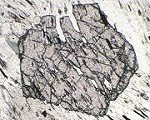Practical Aspects of Mineral Thermobarometry
Non-ideal mixing
Activity coefficient (one-site substitution)
If the mixing is non-ideal, we can introduce a factor
![]() (gamma), the activity coefficient, so that
where substitution of cation j occurs on n sites per formula unit,
e.g. (Ca,Mg,Fe)CO3, the activity of the j-rich end
member i will be
(gamma), the activity coefficient, so that
where substitution of cation j occurs on n sites per formula unit,
e.g. (Ca,Mg,Fe)CO3, the activity of the j-rich end
member i will be
ai = (Xj![]() j)n
j)n
where X is the mole fraction of cation i on the site and ![]() is the activity
coefficient.
is the activity
coefficient.
Ideal and non-ideal solutions
In an ideal solution, the activity coefficient is 1, and so a = X. In non-ideal solutions, the activity coefficient will have some value greater or smaller than one, which will be a function of composition, temperature, and perhaps other variables. Careful experimental work is needed to determine its values. Solid solution series which show miscibility gaps at lower temperatures are clearly non-ideal.
More reading for this section can be found in
- Spear (1993)
- Thermodynamics of mixtures, Ch 6 pp. 153-163 (Entropy of mixing, G-X diagrams)
- Ideal solutions
- Non-ideal activity models, Chapter 7
- Andrew Putnis (1992) Introduction to Mineral Sciences. Cambridge University Press
- Roger Powell (1978) Equilibrium Thermodynamics in Petrology
- Wood, B.J. and Fraser D.G. (1977) Elementary Thermodynamic for Geologists. Oxford University Press.
[ Notes for further content in these sections ... ]
Energetics of ideal solutions
Free energy of an ideal solution. Figure (G-X)
Configurational entropy of mixing only, no enthalpy of mixing, volumes are linear across range.
Real Solutions
Follow Spear, Ch 7, , pp. 191-
Raoult's and Henry's Laws [diagram]
Gibbs energy: ideal and excess parts
Series expansion of excess free energy, giving symmetrical or asymmetrical properties
Symmetrical (truncated at quadratic term) sometimes called regular solutions
Mixing parameters
Excess free energy, mixing parameters. Figure(s) (G-X)
Spear fig 7-9 helps to define WG (Margules parameter or mixing parameter), showing its relationship to Henry's Law coefficient.
Show relationship between activity coefficient and WG
Figures and expressions for A-X relations for non-ideal binary system. Most relevant example might be muscovite-paragonite.
Formulations for ternary and quaternary solutions
Generalised 1-site asymmetric (Spear 1993, p. 204) [no space for full expansions]
Typical application is to Fe-Mn-Mg-Ca garnets
Many parameters, poorly constrained by data; commonly assume many are zero or negligible.
This page last modified 12 October 2004
